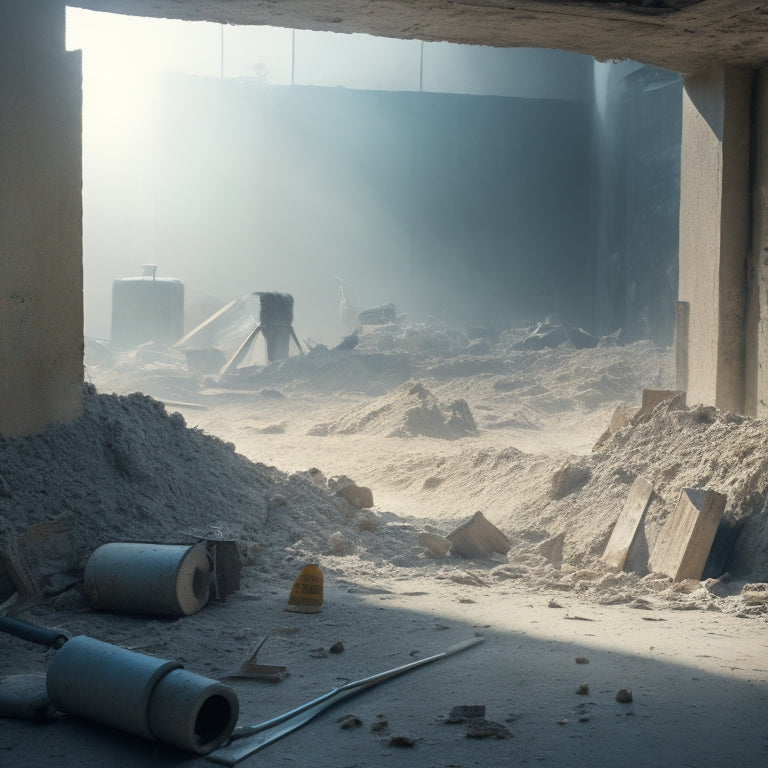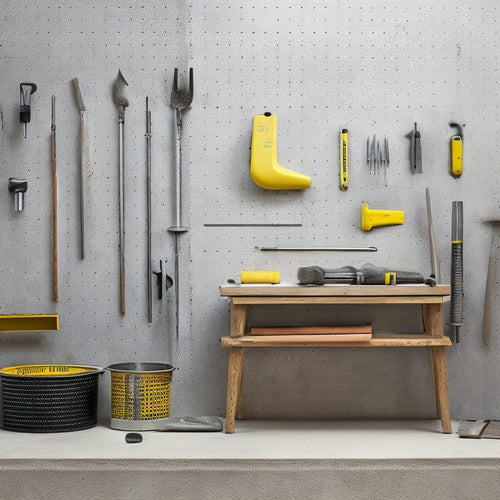
Why You Need These Concrete Demolition Tools
Share
You need the right concrete demolition tools to guarantee efficient, safe, and cost-effective removal of concrete structures. Without them, you risk project delays, increased labor costs, and worker injuries. Having the right tools, such as demolition saws, jackhammers, wrecking bars, and concrete drilling machines, allows you to tackle specific tasks with precision and control. Whether it's heavy lifting, detail work, or manual labor, each tool plays an essential role in your project's success. By understanding the functions and benefits of each tool, you'll be better equipped to take on complex demolition tasks and explore the latest innovations in the industry.
Key Takeaways
• Precise cuts and control are ensured with demolition saws, reducing damage to surrounding structures and enhancing overall project efficiency.
• Jackhammers and pneumatic breakers enable fast and efficient demolition of thick concrete slabs, making them essential for large-scale projects.
• Wrecking bars, chiseling hammers, and hand tools provide targeted pressure application and precision for nuanced demolition tasks, reducing damage and waste.
• Demolition robots automate the process, reducing labor costs, minimizing waste, and enhancing project efficiency, making them a valuable investment for large projects.
• Safety gear, including general safety gear, eye protection, and head and body shields, is crucial for protecting workers from hazardous debris and materials, ensuring a safe working environment.
Demolition Saws for Precise Cuts
When tackling concrete demolition projects, you'll often rely on demolition saws to make precise cuts, particularly in areas where overcutting or damaging surrounding structures is a concern. These powerful tools allow you to make accurate cuts, minimizing the risk of damage to adjacent surfaces.
To achieve the best results, it's crucial to master various cutting techniques, such as plunge cutting, rip cutting, and flush cutting. Each technique requires a specific blade type, which can be either diamond-coated or abrasive.
Diamond-coated blades are ideal for cutting through hard materials, like reinforced concrete, while abrasive blades are better suited for softer materials, like asphalt. By selecting the right blade type and cutting technique, you'll be able to make precise, controlled cuts, even in confined spaces.
Additionally, demolition saws can be equipped with various accessories, such as dust suppression systems and vacuum attachments, to enhance operator safety and reduce environmental impact.
Jackhammers for Heavy Lifting
You'll need to switch gears from precise cutting to heavy lifting, as jackhammers take center stage in concrete demolition projects that require breaking up thick slabs or removing large chunks of concrete. These powerful tools are designed to deliver maximum force, making them indispensable for heavy-duty demolition tasks.
To get the most out of your jackhammer, it's important to master various jackhammer techniques, such as proper grip, stance, and striking techniques. This will help you maintain control and generate maximum force.
Regular jackhammer maintenance is also essential to guarantee peak performance and extend the tool's lifespan. This includes checking and replacing worn-out bits, lubricating moving parts, and storing the tool properly when not in use. A well-maintained jackhammer will deliver consistent results and help you complete projects efficiently.
Wrecking Bars for Prying Power
For more nuanced demolition tasks, like prying apart concrete sections or removing stubborn debris, wrecking bars offer a precise, controlled approach that's often more effective than brute force.
You'll find wrecking bars particularly useful in applications where you need to carefully pry open cracks or seams in concrete without causing further damage. These versatile tools allow you to apply targeted pressure, making them ideal for delicate prying techniques.
When selecting a wrecking bar, consider the type of demolition task at hand. For example, a flat, wide bar is perfect for prying apart concrete slabs, while a pointed, curved bar is better suited for removing debris from tight spaces.
You'll also want to choose a bar that's durable enough to withstand the rigors of repeated use.
Concrete Drilling Machines
As you move beyond prying and into making precise holes in concrete, a concrete drilling machine becomes your go-to tool. This equipment allows you to execute complex drilling techniques with ease, making it an essential asset for any concrete demolition project.
With a concrete drilling machine, you can create precise holes for anchors, pipes, or conduit runs, ensuring a solid foundation for your builds. The machine's rotary action and robust motor enable you to penetrate even the toughest concrete cores, making it an indispensable tool for heavy-duty projects.
Whether you're working on a large-scale construction site or a small-scale renovation, a concrete drilling machine's versatility and power make it an invaluable addition to your toolkit.
Chiseling Hammers for Detail Work
When you're working on concrete demolition projects that require precision, you'll find that chiseling hammers are ideal for detail work.
You'll use them to break up concrete, remove old flooring, and smooth out edges - tasks that demand control and finesse.
In these situations, a chiseling hammer's versatility and maneuverability will be essential to getting the job done efficiently.
Breaking Up Concrete
You'll often find yourself relying on chiseling hammers for detail work when breaking up concrete, as they provide the precision and control needed to dismantle concrete structures without causing unnecessary damage.
When it comes to breaking up concrete, you'll need to employ concrete cracking techniques that allow you to carefully dismantle the structure without causing collateral damage. This is especially important when working in tight spaces or when trying to salvage materials for eco-friendly disposal.
Here are some key considerations to keep in mind:
-
Choose the right chisel: Select a chisel that's specifically designed for concrete demolition to guarantee maximum effectiveness and safety.
-
Apply controlled force: Use controlled, precise blows to avoid over-penetrating the concrete and causing unnecessary damage.
-
Work in small sections: Divide the concrete into smaller sections to maintain control and avoid causing widespread damage.
Removing Old Flooring
Removing old flooring requires meticulous attention to detail, especially when tackling stubborn adhesive residue, and that's where chiseling hammers prove invaluable for precision removal.
When it comes to flooring removal techniques, you need a tool that can deliver controlled blows to dislodge old flooring without damaging the underlying surface. Chiseling hammers are perfect for this task, allowing you to target specific areas with precision and accuracy.
As you work to remove old flooring, you'll encounter various types of adhesive residue, from thinset to epoxy-based adhesives. Chiseling hammers enable you to adapt your technique to suit the specific type of flooring and adhesive you're dealing with.
By using a chiseling hammer, you can guarantee that the surface is properly prepared for new flooring installation, which is critical for a successful surface preparation method.
With the right chiseling hammer in your arsenal, you'll be able to tackle even the most challenging flooring removal projects with confidence and precision. By doing so, you'll set yourself up for success in the next phase of your project.
Smoothing Out Edges
With the old flooring removed, you're left with rough edges that require attention, and that's where a chiseling hammer's precision comes into play for smoothing out these areas with finesse. These hammers are designed for detail work, allowing you to refine edges and surfaces with precision and control.
For effective edge finishing techniques, you'll want to focus on the following key areas:
-
Removing excess material: Use your chiseling hammer to carefully chip away excess concrete, creating a smooth surface for finishing.
-
Refining edges: Employ precise strikes to shape and refine edges, ensuring a clean, defined finish.
-
Preparing for finishing coats: Smooth out surfaces to create an even base for subsequent finishing coats, ensuring a professional-looking result.
Safety Gear for Protection
As you prepare to tackle concrete demolition projects, you'll need to prioritize safety above all else.
You're about to learn about the essential safety gear that'll protect you from hazardous debris and materials.
Specifically, you'll discover the importance of eye protection essentials and head and body shields in preventing serious injuries.
Eye Protection Essentials
You must wear ANSI-approved safety glasses or goggles that provide 360-degree protection to shield your eyes from flying debris and dust when operating concrete demolition tools. This is vital because eye injuries can be severe and even permanent.
Furthermore, adhering to eye safety regulations is essential to avoid workplace accidents and guarantee compliance with industry standards.
When it comes to eye protection types, you have several options to choose from:
-
Prescription safety glasses: designed for individuals who wear corrective lenses, these glasses provide clear vision and protection.
-
Goggles: offer a snug fit around your eyes and protect against chemical splashes and large debris.
-
Face shields: provide additional protection for your face and eyes from flying particles and chemical splashes.
Head and Body Shields
Beyond protecting your eyes, it's imperative to shield your head and body from the harsh consequences of concrete demolition, which is where head and body shields come into play. These protective gear are designed to absorb and deflect impact, protecting you from flying debris, dust, and other hazards associated with concrete demolition.
When choosing head and body shields, consider the level of protection you need. Here's a breakdown of some key features to look for:
| Feature | Description |
|---|---|
| Material | Look for high-impact resistant materials like polycarbonate or ABS. |
| Coverage | Opt for shields that provide full-face protection, including forehead, nose, and mouth. |
| Adjustability | Choose shields with adjustable straps for a secure, customizable fit. |
| Weight | Lighter shields can reduce fatigue, but make sure they still provide adequate protection. |
Pneumatic Breakers for Speed
Relying on pneumatic power, breakers deliver rapid demolition capabilities, making them an ideal choice for projects where speed is essential. You'll appreciate the pneumatic breaker advantages when you need to demolish large areas quickly. These powerful tools are designed to handle tough concrete demolition tasks, making them a valuable addition to your toolkit.
Here are just a few reasons why pneumatic breakers stand out:
-
Faster demolition: Pneumatic breakers can demolish concrete up to 5 times faster than manual methods, saving you time and labor.
-
Increased power: With pneumatic power, you can tackle thick, reinforced concrete with ease, making them perfect for large-scale projects.
-
Reduced fatigue: By taking the strain off your body, pneumatic breakers reduce operator fatigue, allowing you to work for longer periods without rest.
To guarantee your pneumatic breaker continues to perform at its best, regular pneumatic tool maintenance is vital. This includes daily checks on air pressure, lubrication, and worn parts, as well as following the manufacturer's guidelines for maintenance and repair.
Hand Tools for Manual Labor
When you're tackling concrete demolition projects that require more precision and control, you'll need to rely on hand tools for manual labor.
You'll use these tools to break up concrete slabs and pry up foundation walls, among other tasks.
In the following sections, we'll explore the specific hand tools you'll need to get the job done efficiently and effectively.
Break Up Concrete Slabs
You'll need a set of hand tools to manually break up concrete slabs, ranging from basic equipment like hammers and chisels to more specialized tools like demolition bars and pavement breakers.
When tackling a concrete slab removal project, it's crucial to have the right tools for the job. The thickness of the concrete slab will dictate the type of tools you'll need, as well as the slab removal techniques you'll employ.
Here are some important hand tools to take into account:
-
Hammers: For general demolition work and breaking up small areas of concrete
-
Chisels: For precision work, such as removing small sections of concrete or creating control joints
-
Demolition bars: For prying and breaking up larger sections of concrete
Pry Up Foundation Walls
To pry up foundation walls, you'll need a combination of hand tools that provide the necessary leverage and force to dislodge the concrete from the underlying soil or footing. This process requires precision and control to avoid damaging the surrounding structure. For foundation repairs, you'll need a set of hand tools that can deliver the right amount of force without compromising wall stability.
A claw bar or wrecking bar is vital for prying up foundation walls. These tools provide the necessary leverage to dislodge the concrete, and their curved or angled ends allow for better grip and control. You'll also need a hammer or maul to drive the bar into the gap and break the bond between the concrete and soil. Additionally, a shovel or trenching tool can be used to remove debris and create space for the prying tools.
When prying up foundation walls, it's important to work methodically and carefully to avoid causing further damage. Start by creating a gap in the wall, then use your hand tools to gradually pry the concrete away from the footing. With the right tools and techniques, you'll be able to complete the job efficiently and effectively, ensuring a successful foundation repair.
Demolition Robots for Efficiency
Demolition robots have revolutionized the concrete demolition process by increasing efficiency and reducing labor costs, allowing contractors to complete projects faster and more cost-effectively.
By leveraging advanced robot capabilities, you can automate demolition tasks, reducing the need for manual labor and minimizing the risk of accidents. This means you can complete projects on time, within budget, and with greater precision.
Here are just a few benefits you can expect from using demolition robots:
-
Increased productivity: Demolition robots can work around the clock, without breaks, to get the job done faster.
-
Improved accuracy: Robots can be programmed to precision-demolish concrete structures, reducing waste and minimizing damage to surrounding materials.
-
Enhanced safety: By removing human operators from the demolition zone, you can greatly reduce the risk of injury or accident.
Dust Control Systems for Cleanup
As you automate demolition tasks with robots, you're likely to generate a significant amount of dust and debris. This makes it imperative to implement effective dust control systems for efficient cleanup and environmental protection.
To minimize the risks associated with dust and debris, you need to invest in reliable dust extraction techniques and air filtration systems. These systems will help contain and remove dust particles from the air, guaranteeing a cleaner and healthier working environment.
Dust control systems are designed to capture and filter dust particles, preventing them from spreading to other areas of the site. By incorporating these systems into your demolition process, you can reduce the risk of respiratory problems, minimize equipment damage, and comply with environmental regulations.
Additionally, efficient dust control systems enable you to work faster and more efficiently, as you'll spend less time on cleanup and more time on demolition tasks.
With the right dust control systems in place, you can guarantee a safer, more productive, and more environmentally friendly demolition process.
Frequently Asked Questions
Can I Use Demolition Tools for Other Construction Tasks?
You're wondering if you can repurpose demolition tools for other construction tasks. The answer is yes!
These tools offer alternative uses beyond concrete demolition, thanks to their versatility. You can utilize a demolition hammer for breaking up asphalt, a rotary hammer for drilling through masonry, or a wrecking bar for prying apart wooden structures.
Are There Any Eco-Friendly Concrete Demolition Options Available?
You're looking for eco-friendly concrete demolition options, and you're in luck! Sustainable demolition methods are gaining traction, offering green alternatives to traditional practices.
You can opt for mechanical demolition using attachments like pulverizers or crackers, which reduce waste and minimize environmental impact.
Additionally, consider using hydraulic breakers with silenced operation to minimize noise pollution.
These innovative solutions enable you to demolish concrete efficiently while keeping the planet in mind.
How Do I Maintain and Store Demolition Tools Properly?
Safeguard your setup by scrupulously storing and maintaining your demo tools.
You'll want to carefully clean each tool after use, paying attention to crevices and corners where debris can accumulate.
Organize your arsenal in a logical, accessible manner, ensuring easy retrieval when the next project pops up.
Proper tool cleaning and organization will prolong their lifespan, saving you time and money in the long run.
Can I Rent Demolition Tools Instead of Buying Them?
You're considering renting demolition tools instead of buying them. That's a smart move.
When you weigh the cost comparison, renting often emerges as the more cost-effective option, especially for infrequent or one-time projects.
Rental advantages include reduced upfront costs, minimized storage requirements, and access to specialized tools without the long-term commitment.
You'll get the job done without breaking the bank.
Are There Any Local Regulations for Concrete Demolition Projects?
'Measure twice, cut once' is a mantra you should live by when tackling concrete demolition projects.
Before you start, you'll need to check if there are local permits required for your project. Don't assume you can just start demolition without checking - it's vital to guarantee you're meeting local safety standards.
You'll need to research and obtain the necessary permits to avoid fines or project delays.
Conclusion
As you prepare to take on your concrete demolition project, remember that having the right tools is key to success. Without them, you'll be like Hercules trying to slay the Hydra with a toothpick.
With the right arsenal, you'll be unstoppable, like a titan tearing down walls. From demolition saws to dust control systems, each tool plays an essential role in getting the job done efficiently and safely.
Don't go into battle unprepared - equip yourself with the concrete demolition tools you need to conquer the task at hand.
Related Posts
-

10 Must-Have Tools for Concrete Repair Organization
You'll need a solid organization system to keep your concrete repair tools and materials within easy reach, protected...
-

Ergonomic Concrete Tools for Tight Spaces
When you're tackling concrete work in tight spaces, ergonomic tools are your best bet for comfort and efficiency. The...
-

Top Mixing Tools for DIY Concrete Block Laying
When it comes to DIY concrete block laying, the right mixing tools are vital for a strong and durable structure. You'...


